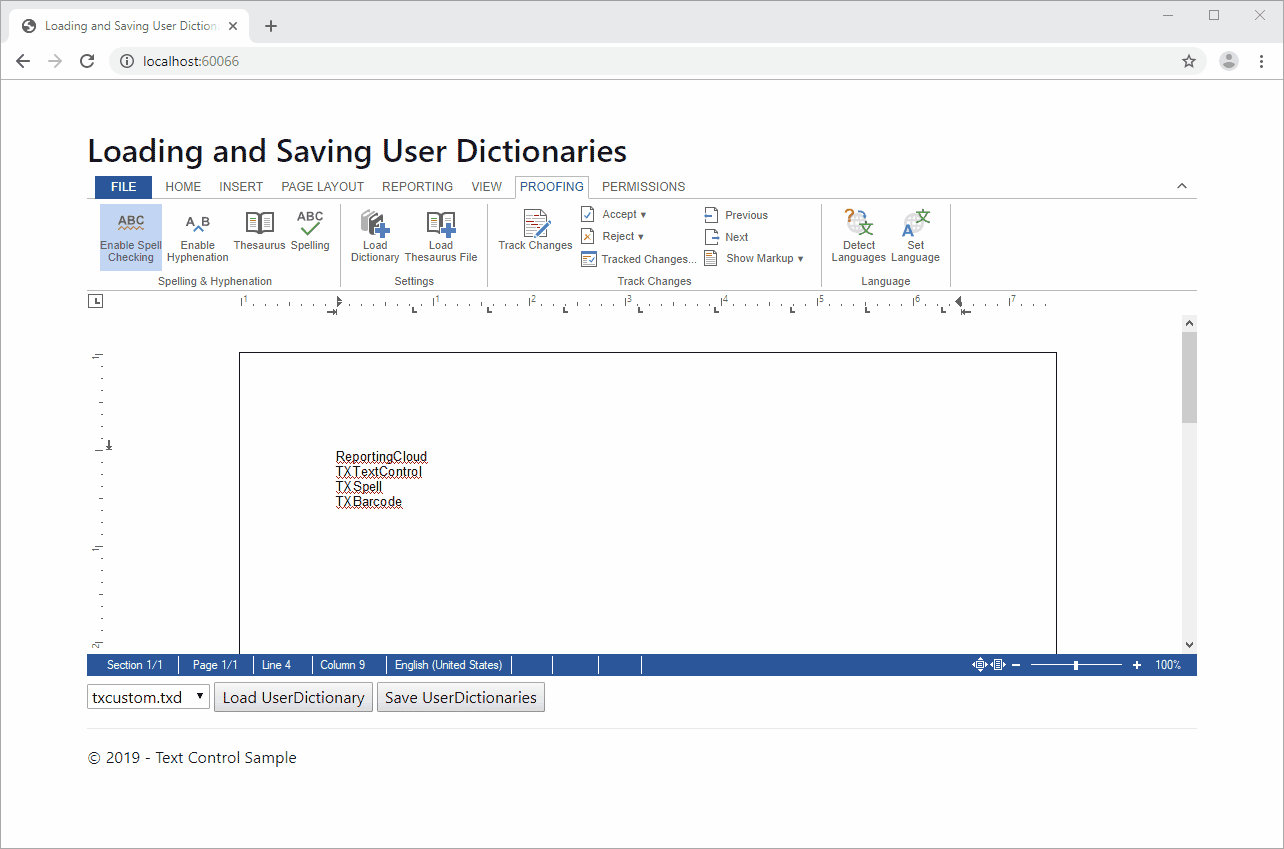Loading and Saving User Dictionaries in TextControl.Web
This article shows how to load and save user dictionaries using a Web API and JavaScript.

When using spell checking in our online editor, dictionaries that are located in the Dictionaries folder of the synchronization service are loaded automatically. That includes all OpenOffice dictionaries and user dictionaries.
This article explains how to enable spell checking for the HTML5-based online editor:
Web.TextControl and Spell Checking
A very common task is to load user specific user dictionaries for each individual user. Therefore, the JavaScript API provides methods to load and save user dictionaries locally. In order to load dictionaries from the server, you will need to retrieve the dictionary from the server and load it into the editor.
In this sample, we created a Web API to handle user dictionaries:
public class DictionaryController : ApiController
{
// returns all user dictionaries in the specific folder
[System.Web.Http.HttpGet]
public HttpResponseMessage UserDictionaryFilenames()
{
var sFilenames = System.IO.Directory
.EnumerateFiles(System.Web.Hosting.HostingEnvironment.MapPath("~/Dictionaries/"),
"*.txd", System.IO.SearchOption.TopDirectoryOnly)
.Select(System.IO.Path.GetFileName);
return new HttpResponseMessage()
{
StatusCode = HttpStatusCode.OK,
Content = new ObjectContent<string[]>(sFilenames.ToArray(),
new JsonMediaTypeFormatter())
};
}
// loads a specific dictionary by filename
[System.Web.Http.HttpGet]
public HttpResponseMessage LoadUserDictionary(string filename)
{
UserDictionary userDictionary = new UserDictionary() {
language = "en-US",
name = filename
};
// read all lines from the dictionary
string[] sDictionaryLines = System.IO.File.ReadAllLines(
System.Web.Hosting.HostingEnvironment.MapPath("~/Dictionaries/" + filename));
// skip the first entry (encoding)
userDictionary.words = sDictionaryLines.Skip(1).ToArray();
// return the object
return new HttpResponseMessage()
{
StatusCode = HttpStatusCode.OK,
Content = new ObjectContent<UserDictionary>(userDictionary,
new JsonMediaTypeFormatter())
};
}
// saves a specific dictionary
[System.Web.Http.HttpPost]
public HttpResponseMessage SaveUserDictionary([FromBody] UserDictionary dictionary)
{
// get all words and save the dictionary
List<string> dictionaryLines = new List<string>();
dictionaryLines.Add("SET iso-8859-1");
dictionaryLines.AddRange(dictionary.words);
System.IO.File.WriteAllLines(System.Web.Hosting.HostingEnvironment.MapPath(
"~/Dictionaries/" + dictionary.name), dictionaryLines);
return new HttpResponseMessage()
{
StatusCode = HttpStatusCode.OK,
Content = new ObjectContent<string>("UserDictionary " +
dictionary.name + " successfully saved.", new JsonMediaTypeFormatter())
};
}
}The Web API contains 3 endpoints:
- UserDictionaryFilenames
This endpoint returns all user dictionary filenames in the created folder Dictionaries. - LoadUserDictionary
This endpoint loads a specific dictionary by filename. - SaveUserDictionary
This endpoint saves a specific dictionary.
On loading the page, all available dictionaries are listed in a drop-down box:
// get available dictionary names and add them to select element
function getUserDictionaryFilenames() {
var serviceURL = "/api/Dictionary/UserDictionaryFilenames/";
$.ajax({
type: "GET",
url: serviceURL,
contentType: 'application/json',
success: successFunc,
error: errorFunc
});
function successFunc(data, status) {
data.forEach(function (item) {
// append the options
$("#availableDictionaries").append("<option>" + item + "</option>");
});
}
function errorFunc() {
console.log("error");
}
}If a dictionary is selected and the button Load UserDictionary is clicked, the selected dictionary is loaded asynchronously using JavaScript:
// load a specific user dictionary
function loadUserDictionary() {
// call Web API endpoint to retrieve the dictionary
var serviceURL = "/api/Dictionary/LoadUserDictionary?filename="
+ $("#availableDictionaries").val();
$.ajax({
type: "GET",
url: serviceURL,
contentType: 'application/json',
success: successFunc,
error: errorFunc
});
function successFunc(data, status) {
// enable spell checking
TXTextControl.isSpellCheckingEnabled = true;
// load user dictionary
TXTextControl.Proofing.loadUserDictionary(data.name, data.words, data.language);
alert("Dictionary " + data.name + " successfully loaded.");
}
function errorFunc() {
console.log("error");
}
}If the button Save UserDictionaries is clicked, all dictionaries are saved back on the server:
function saveUserDictionary() {
// get information about all user dictionaries
TXTextControl.Proofing.getUserDictionaryInfo(function (e) {
// loop through all dictionaries
e.forEach(function (item) {
// save the dictionary
TXTextControl.Proofing.saveUserDictionary(item.name, function (name, words) {
// create a new dictionary JSON object
var userDict = { language : item.language, name : name, words : words };
// call the Web API and pass the dictionary object
var serviceURL = "/api/Dictionary/SaveUserDictionary/";
$.ajax({
type: "POST",
url: serviceURL,
contentType: 'application/json',
dataType: "json",
data: JSON.stringify(userDict),
success: successFunc,
error: errorFunc
});
function successFunc(data, status) {
alert(data);
}
function errorFunc() {
console.log("error");
}
});
});
})
}The following animation shows this sample in action:

This this on your own and download the sample from our GitHub repository.
![]()
Download and Fork This Sample on GitHub
We proudly host our sample code on github.com/TextControl.
Please fork and contribute.
Requirements for this sample
- Visual Studio 2017 or better
- TX Text Control .NET Server (trial sufficient)
ASP.NET
Integrate document processing into your applications to create documents such as PDFs and MS Word documents, including client-side document editing, viewing, and electronic signatures.
- Angular
- Blazor
- React
- JavaScript
- ASP.NET MVC, ASP.NET Core, and WebForms
Related Posts
Getting Started: ServerTextControl and MailMerge with ASP.NET MVC (.NET…
This article shows how to use the TX Text Control ASP.NET ServerTextControl and MailMerge classes within an ASP.NET web application in Visual Studio 2022.
Getting Started: Document Viewer with ASP.NET MVC (.NET Framework)
This article shows how to use the TX Text Control ASP.NET document viewer within a .NET Framework web application in Visual Studio 2022.
Getting Started: Document Editor with ASP.NET MVC (.NET Framework)
This article shows how to use the TX Text Control ASP.NET document editor within a .NET Framework web application in Visual Studio 2022.
ASP.NETJavaScriptDocument Editor
Detect Toggle Button Changes Using a MutationObserver
This article shows how to detect changes of toggle buttons in the ribbon of the web editor using a MutationObserver. The state of a toggle button in the ribbon visualizes the state of a certain…
ASP.NETJavaScriptDocumentViewer
Using the MVC DocumentViewer in ASP.NET Web Forms
The ASP.NET MVC DocumentViewer for ASP.NET provides more features including document signing capabilities than the DocumentViewer for Web Forms. This article shows how to use the MVC…






